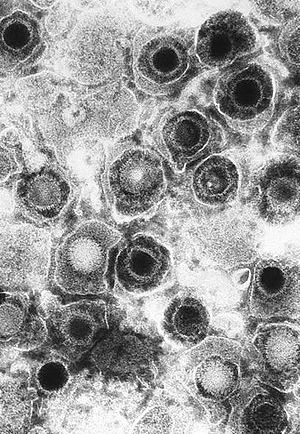Category:Herpesviridae
Herpesviridae
Herpes viruses are some of the more difficult viruses to combat as they quite contentedly go latent for long periods of time. They often produce an initial respiratory response but go subclinical until the animal becomes immunosuppressed. Protection against herpes is challenging, as immunity relies on stimulating a CD8+ T-cell response, which is difficult to provoke by conventional vaccination.
Content
Morphology
- Double stranded DNA that becomes a closed circle in the host nucleus
- Remains unintegrated while latent
Virulence and Pathogenesis
- Three types of genes involved in replication:
- Immediate early genes (IE genes): strong promoter of the expression of adjacent viral genes
- Early genes: stimulate viral DN replication; potential cause of lymphoproliferation and tumors in the absence of cell lysis
- Late genes: encode viral structural proteins
- Cause large intranuclear inclusion bodies typical of herpes viruses as capsid proteins are assembled
- Envelope buds through nuclear membrane, containing spike glycoproteins (gA to gE)
- Masses of virus then either lyse or fuse cells, causing ulceration, etc.
- Initial replication in respiratory tract
- Spread determines pathogenicity:
- Cell-associated spread means that virus is spread by cell fusion
- Can target crucial tissues: brain, placenta, etc
- All become latent and reactivate under stress
- Reactivation is associated with the presence of thymidine kinadse (tk) gene (which is deleted in GE vaccines)
- Accelerates DNA synthesis
Research
- Some herpes and pox viruses express non-structural proteins known as virokines
- Virokines appear to help the virus evade the Th-1 response by altering the inflammatory response
Virus by Species
| Virus | Abbreviation | Clinical signs |
|---|---|---|
| Equine Herpesvirus 1 | EHV1 | Respiratory disease, abortion, paresis |
| Equine Herpesvirus 2 | EHV2 | Avirulent |
| Equine Herpesvirus 3 | EHV3 | Pustular lesions on genitalia |
| Equine Herpesvirus 4 | EHV4 | Mild respiratory disease |
| Bovine Herpesvirus 1 | BHV 1
IBVR IPVV |
IBRV: Upper respiratory disease, abortion
IPVV: Irritant pustular lesions on genitalia |
| Bovine Mammilitis Virus | BHV2 (BHMV) | Erosive lesions on teat and udder, Zoonotic |
| Malignant Catarrhal Fever Virus | MCFV | Infection of eye and upper respiratory |
| Suid Herpesvirus 1 (Pseudorabies) | PSV | Respiratory disease, abortion (CNS in piglets, pruritis in cattle) |
| Suid Herpesvirus 2 (Porcine Cytomegalovirus) | PCMV | Subclinical, atrophic rhinitis |
| Canine Herpesvirus 1 | CHV1 | Fading puppies, repro failure |
| Feline Herpesvirus 1 | FHV1 | Rhinitis, bronchitis |
| Channel Catfish virus | Death with hemorrhage | |
| Koi herpes | Death with gill necrosis | |
| Herpesvirus cyprini | Carp pox, also in goldfish | |
| Elephant endotheiliotropic herpes virus | African elephant: mild, skin papillomas
Indian elephant: FATAL with hemorrhage | |
| Gallid Herpesvirus 1 | MDV | Lymphoproliferative, invades CNS, visceral tumors |
| Gallid Herpesvirus 2 | HVT | Avirulent, protective |
| Gallid Herpesvirus 3 (Infectious Laryngo-tracheitis) | AHV1 (ILT) | Tracheitis and bronchitis |
| Duck Plague Virus | Endothelial and enteric lesions | |
| Pigeon Herpesvirus | Respiratory disease | |
| Mareks Disease | MDV | Paralysis, encephalitis |
| Psittacid and Raptor Herpes | Death with yellow diarrhoea and coma | |
| Herpesvirus B (Monkeys) | Potential zoonosis; oral ulcers in Asiatic monkeys, fatal encephalitis in man |
Pathology
Liver herpesvirus infections:
- Look for the intranuclear inclusions in surrounding surviving hepatocytes
| Herpesviridae Learning Resources | |
|---|---|
To reach the Vetstream content, please select |
Canis, Felis, Lapis or Equis |
Pages in category "Herpesviridae"
The following 18 pages are in this category, out of 18 total.
